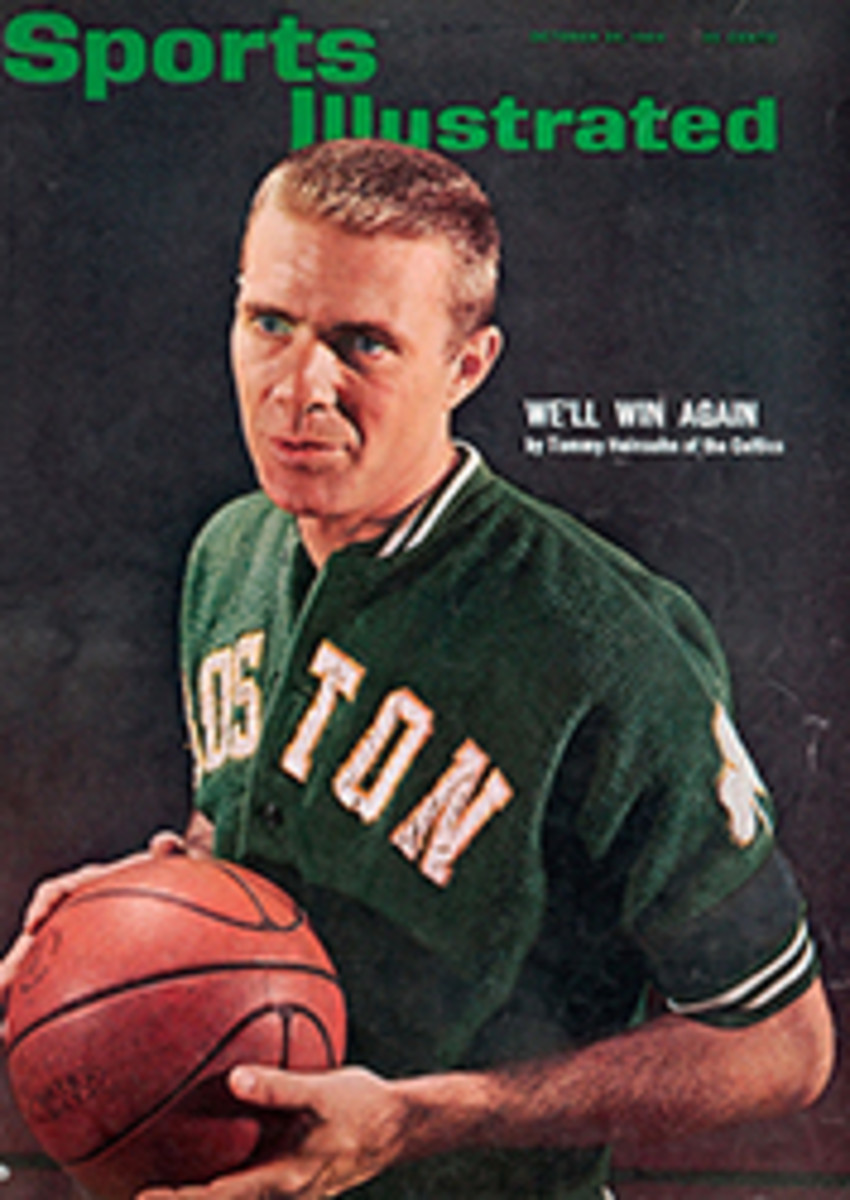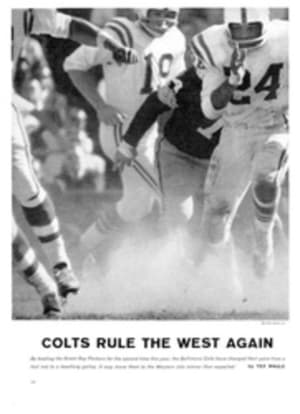
'Wahoo! Wahoo! Wahoo!'
It began on Saturday, Sept. 12, 1964, the first time he was introduced in Shea Stadium. While the public address system was still booming his name, the chant began: "Wahoo! Wahoo! Wahoo!" It was as if 50,000 people had sat on lighted cigarettes at the same instant. And from that moment New York, after eight years of adoring Sam Huff, had a new middle linebacker to worship. For the Jets, and for himself, Wahoo McDaniel arrived at absolutely the perfect hour, with the Giants stumbling and Huff traded away to Washington and the American Football League rushing toward prosperity. "I told Wahoo if he went to New York and did a good job he could make a fortune," said former Denver Bronco Coach Jack Faulkner, who traded McDaniel to the Jets last winter in a nine-player deal. "He has a great sense of timing, both on the field and off."
Undoubtedly, the New York Jets own better athletes than Ed McDaniel. a 240-pound Choctaw-Chickasaw Indian who plays middle linebacker as if it were the last wild charge at the Little Big Horn. Deep Receivers Don Maynard and Bake Turner, skinny Quarterback Dick Wood, rookie Fullback Matt Snell and lightweight Linebacker Larry Grantham all may have more genuine football ability than Wahoo McDaniel. But no other Jet has ever managed to fascinate and beguile New York's professional football addicts the way Wahoo does. He owes much of his success to the popularity of Huff. If there is no Sam Huff in town, the New York fans will create one. Wahoo was shrewd enough to realize that as soon as he was traded.
"This place ain't big enough for me and Huff," Wahoo announced. "It's lucky for him he moved." After that statement, which was reported with mingled delight and astonishment by the New York press, people began to watch Wahoo. He has responded by demolishing any ballcarrier he can reach, which is anybody who runs into the fairly compact area that Wahoo's lack of speed limits him to. "When I said that about Huff, it was a rib," Wahoo said. "I sure didn't mean to be sarcastic. But everybody picked it up, and that was fine, too. Right away they knew I was out there."
But even Wahoo was startled by the noisy welcome he got on opening night in New York. With the crowd obviously searching for a hero, the Jets were alert and began to build up whatever Wahoo did and a few things he did not. His round, cheerful face was constantly flashed on the big Jet-o-rama sign out on the scoreboard. Wahoo was credited with knocking down every pass that did not hit the goal posts and with tackling every runner who was not sitting on the bench. It got so the public address announcer would ask the crowd WHO made that tackle, and the crowd would shout, "Wahoo! Wahoo! Wahoo!"
"I've played hard every year, but I've only had so-so recognition," Wahoo said. "This year I'm playing harder than ever. But the way that crowd reacted the first night surprised me. I was anxious for the second game to see if it kept up." The Jets gave him a new jersey with "Wahoo" sewn on the back above the number 54. And the crowd enthusiasm did keep up. "All the applause Wahoo got in three years at Denver wouldn't amount to half of what he gets in one yell in New York," said Harry Farrar of The Denver Post.
A byproduct of Wahoo's sudden fame will be more lucrative wrestling contracts, for it is as a wrestler with the name Chief Wahoo that he earns the most money. Wahoo began wrestling in 1961 when an Indianapolis promoter was looking for an Indian—any large Indian with muscles and a colorful nature—and somebody remembered that Wahoo had turned out for the wrestling team at the University of Oklahoma. "I wasn't a very good rassler in college, but the rasslers weren't very good football players either," Wahoo said. "The guy in Indianapolis said don't worry, they would teach me. That was six weeks before the football season began, and I rassled every night. Last year from January 1 until training camp I had 160 matches, sometimes two on Thursdays, all over Texas and in Albuquerque, Denver, Kansas City, places like that. I've gotten to be pretty good. I'm just now a main eventer. It takes five years to be a good pro football player and about that long to be a big-time rassler."
Wahoo wrestles at around 250 pounds, which is 50 pounds more than he weighed as an outstanding running back at Midland (Texas) High School and nearly 70 pounds more than he weighed as a fullback, halfback, end and punter (he had a 91-yard punt in 1958 and averaged more than 40 yards per kick for three years) at Oklahoma. That vast increase in weight has naturally affected Wahoo's mobility. "He's an overstuffed middleweight," said one AFL coach. "At 205 Wahoo could move with authority, but not at 240. The tackles can cut him off on the wide stuff. He can't handle much responsibility on passes. He's a good blitzer and is strong on running plays that come straight at him. But he's a harum-scarum type, and you can't build a solid defense around him."
Such talk puts Wahoo in the mood to attack a wagon train. "My greatest assets are my size and strength," Wahoo said. "I just don't get blocked. If I get blocked more than twice, I had a lousy game. I'm only 6 feet 1, which is short for my weight, but I have tremendous shoulders and arms and can knock off blockers. I have regular pass responsibility. San Diego tried to throw on me six or seven times when we played them this season. They made me cover Paul Lowe. I don't have his speed, but I would stay in there and read whether the play was a run, draw or screen, and then if Lowe came I went with him hard. I've seen the same backs in this league year after year for five years, and I know what they can do and where they're going, and I go with them. I knock down about three passes a game. I intercepted six in the last two seasons, and I'm 50% improved on pass defense this season. Nobody kills me passing."
Confidence, clearly, is a virtue Wahoo has in abundance. He signed as a free agent with the Dallas Cowboys of the National Football League in 1960 although he had been drafted by the Chargers of the AFL, because he had been criticized for leaving his home state to play at Oklahoma and because he thought he could take the middle line-backing job away from Jerry Tubbs, another Texan who had been an All-America at Oklahoma. Wahoo impressed the Cowboys with his toughness. He scrimmaged with a dislocated shoulder and still whacked the runners viciously when he could catch them. "He has an Indian stoicism toward pain," said Cowboy Trainer Clint Houy. But Tubbs was one of the very few reliable players the Cowboys had in those days, and Wahoo was released. "They made a terrible mistake," Wahoo says. He went briefly to the Chargers, but wound up playing 10 games for the Houston Oilers that year and in 1961 moved on to Denver as a linebacker and, for a while, as a punter.
By then Wahoo had also acquired a reputation for causing trouble, most of it to do with finances. "He was a wild Indian," Faulkner said. But Wahoo married a girl named Monta Rae from Wink, Texas, after a one-month courtship, and settled down considerably. They now have a 15-month-old daughter, Nicole. "I'll admit I used to be wild. But that's behind me," Wahoo said. "I don't have time for all that cutting up."
As a New York businessman, Wahoo puts on his size-50 suit and leaves his Long Beach, N.Y. apartment on Mondays—the pros' traditional day off—for important discussions of matters like Wahoo T shirts and possible wrestling contracts in Madison Square Garden. It is quite a far whoop from his home in Midland, an oil town where he and his father, Big Wahoo, used to contemplate the drilling rigs on the burnt prairie. Wahoo may not be as good a middle linebacker as, say, Sherrill Headrick of Kansas City, Archie Matsos of Oakland, Nick Buoniconti of Boston or Chuck Allen of San Diego. Or, of course. Sam Huff. But Wahoo is probably a better wrestler than any of them, and he has improved the Jets' defense, and how many Buoniconti T shirts have you seen lately? A crowd simply could not shout "Headrick! Headrick! Headrick!" with the same delirious glee that it can shout "Wahoo! Wahoo! Wahoo!" The sound is not as joyous, and at Shea Stadium—where a young man drives madly up and down the sidelines in a toy jet plane whenever Wahoo does anything—the sound is mostly for Wahoo McDaniel. "I don't think the other players resent the attention I'm getting," Wahoo said. "They know how I am. I'll play just as hard whether those people holler or not. But it sure does sound sweet." The Jets, with 126,000 paid attendance after three games, agree.
PHOTO
A WRESTLER'S POWERFUL ARMS AND SHOULDERS ARE WAHOO'S BIGGEST ASSETS

